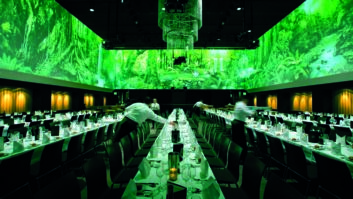Touch of a Button had only been in business two years when the company was invited to tender for a 340 apartment complex in Bulgaria. George Cole reports
Most installers can probably recall a job that’s caused the odd sleepless night – a pressing deadline, a seemingly insurmountable technical problem, or a client who radically changes the brief half way through the process.
Well, think of your worst install nightmare, multiply it by a factor of 10 and you still probably won’t come close to the immense pressure faced by Will Levy and his company Touch of a Button on a project involving a large residential complex in a Bulgarian skiing resort.
Don’t misunderstand – this wasn’t the project from hell. But the sheer size, scope, complexity and logistical hurdles posed by it would have caused many to pause and think: “Why am I doing this?”
This was partly because the project was large, involving 340 apartments, four bars, two restaurants, a conference room, plus
numerous offices, games rooms, reception areas and spas.
It also required a lot of different technology, including audio, video, data and telephony. Plus, it was based overseas from Touch of a Button, in Bankso, Bulgaria to be specific. And, as we shall see, there were still more challenges ahead, many of which were unforeseen.
Despite all these hurdles, Touch of a Button completed the job and the results are highly impressive. So much so, that the project won the best multi-dwelling installation award at the 2008 CEDIA Awards.
Workflow tools – streamlined
Touch of a Button is based in Surrey, England, and was formed in 2004 by Will Levy and friend Toby Pearce. Levy admits that they
came into the install business via unconventional backgrounds: “I ran global technology projects for management and financial institutions such as Accenture, Morgan Stanley and ABN Amro, while Toby’s background was in managing customer service teams.”
Levy adds that when they decided to form Touch of a Button: “We didn’t have any contacts; we didn’t have any clients and we didn’t
know any suppliers – it was a complete blank of piece of paper.” Since then, the company has grown, managing projects worth well over Ä/£1 million at its peak year.
So what did Touch of a Button bring to the market? “It was our project management methodology,” says Levy. “We were used to running complex, full cycle projects – taking initial ideas through to requirements gathering, design and implementation phases. This structured approach allowed us to offer a better customer service than clients were often used to. We weren’t the traditional high street audio dealer going into the install market.”
Levy explains how his company works: “We have streamlined internal processes using workflow tools and databases to collect information at every stage of a project. From this, we can produce detailed documentation without generating a lot of paperwork,” adding that, “A lot of companies in the industry have a background in high street retailing and so are good at selling products, while others may come from the security or electrical contracting sector, and so have a good understanding of how buildings are constructed. Our background is project management.”
Touch of a Button also offers a wide range of services and products that cover home cinema, multi-room AV, lighting, security, data and telecoms, and environmental control. “It was obvious that all these systems were converging,” says Levy, “and that customers would benefit from suppliers offering a complete solution.”
The early days of the business were spent gaining market and technical knowledge, and building relationships with suppliers. Then it was a case of trying to find clients. “That’s why our client base is so wide – it ranges from individual householders to property developers, architects, consultants and interior designers – because we simply had to build up our client base,” says Levy.
If there’s one thing Touch of a Button likes getting involved in it’s “very large, very complex projects that need a high level of service,” says Levy. That certainly was the case regarding this project. In 2006, Levy received a call from a property developer MSI Developments, inviting him to pitch for major development in the White Fir resort in Bulgaria.
The two-phase project would involve building 140 apartments across four buildings, with an additional 200 apartments (spread across four more buildings) to be built in the second phase, all due to be completed in 2008.
At this stage, the plans were rather vague, but the developer knew it wanted to differentiate its apartments through offering a higher technology specification. Many people have an impression of Bulgaria that suggests great poverty, and certainly having little demand for a luxury ski resort, but Levy says: “The country is changing rapidly with new shopping malls and higher quality apartment blocks going up everywhere.” But Bulgaria wants to embrace modernity whilst maintaining much of its rich culture.
Love me tender – competition
After the initial meeting, Touch of a Button was invited to make a formal tender for the White Fir project. “We obviously needed to work with local firms, so I flew out twice to Bulgaria to find local contractors,” says Levy.
These reconnaissance trips were financed by Touch of a Button and were challenging. “Language was a problem,” says Levy, “and we didn’t have translators until we had contracts to sign. We did a lot of research at our own cost to win the tender.”
The trips involved a lot of travelling around Bulgaria to find contacts: “There were times when we were stuck in metres of snow, or I’d be taken to some dodgy backstairs offices, but we made the contacts we needed in order to make a good tender.”
Touch of a Button prepared its tender document. “As you can expect, there was stiff competition for the project and we were also competing against some local Bulgarian firms, so there was a lot of pressure on prices, especially when you consider that the average salary for a Bulgarian is about Ä200 a month,” notes Levy, “but we were able to show a much better value proposition and use modern products.”
The winning tender also included the provision of three optional AV packages – Bronze, Silver and Gold – which residents could select, and if required, upgrade at a later stage.
In almost all installs, there is a degree of ‘mission creep’, where the original brief changes and the job throws up additional demands. But not even Touch of a Button could have imagined the extent to which the White Fir project would expand.
“The developers were clear about the specifics with regard to AV and they knew they wanted broadband. But what we hadn’t appreciated was that there was no infrastructure in place to bring broadband into the buildings,” explains Levy.
This meant having to install a fibre optic network throughout the eight apartment buildings and developing a radio relay system for bringing telecom and data services into the White Fir resort from a small town some five kilometres away. As can be imagined, this involved a lot of extra work which included, managing the engineering work, contacting local landowners to get permission to lay the fibre optic cable across their land, and of course, working with lawyers and surveyors.
Drawing up the various contracts for all the parties involved in the White Fir project was another major undertaking: “We spent thousands of pounds on professional advice from accountants and lawyers,” says Levy, “but it’s a necessary process you have to go through. We had lots of goods stolen [more on this later] and thankfully, we had several insurance policies in place.”
Minute details – contract updates
Another important strategy was that, if something was agreed during a meeting, it was recorded in the minutes and written into the contract. Legally binding contracts are important, Levy considers but he adds, “On a project like this, you’re working with large numbers of people – the client, architects, sub-contractors – and a lot of them are Bulgarian companies. Contracts are useful for clarity of communication, but it’s all about having good relationships. If you can forge these, then you don’t have to fall back on legal contracts.”
Levy was very impressed with the level of workmanship from the Bulgarian subcontractors: “In the UK, it’s difficult to find well-qualified engineers, but it was a pleasure to work with these guys – their engineering skills were very high.” Even so, communication was a challenge: “We used a lot of hand signals and the project required meticulous documentation.”
The latter meant producing documents that were clear and easy to understand, with as little writing as possible. For instance, each installation process was photographed to create an installation manual. System diagrams were also meticulously updated.
Around 700-800 people worked on the White Fir site, with 30-45 of them involved in the install. Touch of a Button worked closely with the project manager, interior designer and architects, re-issuing designs and key updates as the project progressed. New challenges constantly emerged.
For example, all eight buildings needed to share an integrated PBX, to allow communication with every room. “We explained to the developer that, as many of the rooms were rented, there had to be capabilities for a billing system to cope with personal calls on a daily basis,” says Levy.
There were other unforeseen jobs, such as the need to build communication links for an ATM that was to be set-up in the reception area. And there was other extra work too. Bulgaria utilises many different building regulations to the UK, such as the use of concrete ceilings, which put an end to Touch of a Button’s plans to install in-ceiling speakers in the rooms.
“It was very frustrating to discover this change at such a late stage and it cost us a lot of money to solve the problem, which involved using in-wall speakers,” Levy admits.
The install process was phased on a block-by-block basis and Armour’s SystemLine HomeNet formed the distribution hub for the various services including, data, telecoms, TV and multi-room audio. The first fix took between 6-12 months to complete and involved installing Cat5e cable, along with coax and speaker cabling into dry wall boarding.
The second fix involved installing wall sockets, keypads, speakers, amps and the AV system. Each room included multiple wall sockets for MP3 players and CD players, including an in-wall iPod docking station, IRS Video Distribution system for satellite TV channels, telephone system, and wired and wireless internet access, including connectivity in the bathroom and balcony. There were also various bespoke solutions including splash-proof bathroom televisions, home cinemas and programmable control systems. After thorough testing and commissioning, the room would be signed off.
Fir stole – speakers go missing
One weakness at the site was security, and it wasn’t long before theft became a big problem. “The site wasn’t properly secured and so we clamped down on it,” says Levy, “then, the thieves got more ingenious. You’d walk into what looked like a perfectly finished apartment and yet discover that the system wouldn’t work. You’d be scratching your head trying to figure out what was wrong.”
Signal path tests would reveal that every component was working until you got to the speakers, yet the speakers looked perfectly fine on the wall. “But as soon as you took the speaker grilles off, you’d see that they had removed all the internal components – woofers, tweeters and so on- and then carefully put everything else back.”
Around half way through the project, the developers decided that they would like to pitch the apartments at UK visitors and so Touch of a Button managed a gap analysis between the architect’s plans for fire safety and the requirements by UK tour operators. And even at the last minute, there was yet another new request from the client.
“Every installer can tell you about the client who turned down a suggestion for a feature that they didn’t see as being necessary, even though you knew it was useful and only added a fraction to the overall cost” says Levy. “Well, in our case, it was digital signage. When we initially put this idea to the client, they turned it down – they definitely didn’t want digital signage. “Then, at the end of the project – and just 24 hours before a planned opening party – the client came to us asking for digital signage! Fortunately, we had gone ahead and built this into our plans and so we were able to comply with the request.”
The result of all this hard work is a resort that looks stunning from both the outside and the inside. “White Fir complex a good indicator of the direction the country is moving in,” says Levy, “because it utilises traditional Bulgarian building techniques and external styles but has been finished to a high (Western) specification.” Feedback from the staff, who have had direct contact with the residents, is good. “Proof of the pudding was being invited to a late-night staff party where about 30 people were squeezed into a two-bed apartment with music blaring in every room – even the bathroom!” Levy recalls.
Since then, Touch of a Button has also had numerous requests for additional apartment upgrades and commissions for work in the UK. And despite the tough economic climate, White Fir’s apartments have sold extremely well.
Touch of a Button might well relish large, complex projects, but even Levy admits: “I did have a few sleepless nights and my hair wasn’t grey before we took on the project!” But he adds: “At the end of every successful large project there’s a sense of relief, satisfaction and fulfilment. Everyone involved in the project is happy to be associated with it.”







